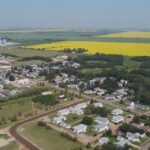Relentless gusts exceeding 60 km/h swept across Saskatchewan’s northern wilderness yesterday, transforming an already dangerous wildfire situation into a nearly uncontrollable crisis. Provincial officials have reported that these erratic winds are dramatically accelerating the spread of multiple wildfires, pushing flames across containment lines and forcing evacuation orders for three additional remote communities.
“We’re fighting a battle on shifting ground,” said Emma Richardson, Saskatchewan’s Chief of Emergency Fire Management during yesterday’s emergency briefing. “The combination of unprecedented dry conditions and these sustained high winds creates a scenario where conventional containment strategies become extremely challenging to implement effectively.”
The largest of these fires, now designated as SK-NR42, has consumed over 25,000 hectares of boreal forest since igniting from a lightning strike five days ago. Satellite imagery reveals the fire front has advanced nearly 12 kilometers in a 24-hour period – a rate that fire behavior analysts describe as “exceptionally aggressive” for this region.
According to provincial data, Saskatchewan has already recorded 178 wildfires in 2025, marking a 42% increase compared to the five-year average for this point in the season. Climate scientists at the University of Saskatchewan have linked this surge to a warming trend that has left the province’s northern forests with moisture levels 35% below normal.
“What we’re witnessing is the manifestation of climate projection models that have long warned about increased fire frequency and intensity,” explained Dr. Nathan Harlow, climatologist at the Prairie Climate Centre. “These aren’t just statistical anomalies anymore – they represent our new reality.”
The provincial government has activated mutual aid agreements with neighboring provinces, bringing in specialized crews from Alberta and Manitoba. Additionally, the Canadian Armed Forces have deployed two CH-147F Chinook helicopters to assist with evacuations from remote areas where road access has been compromised by advancing flames.
For residents of the affected communities, the emotional toll compounds daily. “We had fifteen minutes to decide what to take,” recounted Sarah Morin, who fled from her home in the northern community of La Loche. “How do you choose what matters most when everything you’ve built might be gone tomorrow?”
Provincial officials estimate the firefighting efforts have already consumed $28 million from emergency response budgets, with projections suggesting costs could triple before containment is achieved. This financial strain comes as Saskatchewan was already grappling with recovery expenses from last season’s flood events in southern regions.
The Saskatchewan Public Safety Agency has established evacuation centers in Prince Albert and Saskatoon, where more than 1,200 displaced residents are currently receiving assistance. Health officials are monitoring air quality concerns, as smoke plumes have drifted southward, affecting communities hundreds of kilometers from the active fire zones.
Environmental impact assessments indicate significant wildlife displacement, with particular concern for threatened woodland caribou populations whose habitats intersect with several fire corridors. Forestry experts project that ecological recovery in severely burned areas could require decades, particularly for old-growth stands that provide critical habitat diversity.
As forecasts predict continued dry conditions with only minimal precipitation chances through the coming week, fire management teams are adopting defensive strategies focused on protecting critical infrastructure and populated areas rather than pursuing full containment.
How will these increasingly frequent extreme fire events reshape northern communities’ approach to development, emergency preparedness, and their fundamental relationship with the boreal landscape they’ve called home for generations?
Follow our continuing coverage of this developing situation at CO24 Canada News for hourly updates on evacuation orders and emergency response efforts.

























